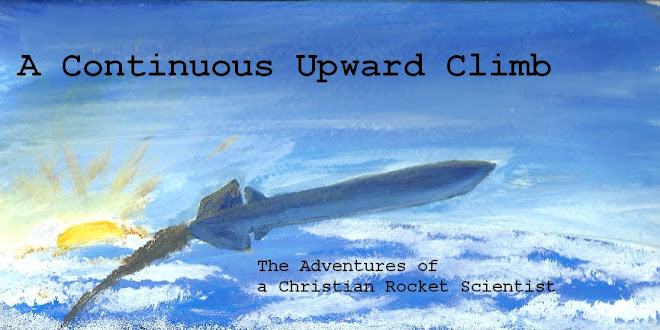9/30/10
Very Lucky Photograph
Taken from Astronomy Picture of the Day (APOD).
9/29/10
USLI
There is a group within the Iowa State Space Society called CySLI, which is a small club that participates in NASA's University Student Launch Initiative (USLI, I call it "Oozli," but I think I'm the only one). I think that this will be one of the coolest activities I will be participating in this year. Basically, USLI is a contest in which Universities design and build both a scientific payload and the launch vehicle to carry it to as close to one mile as possible. So far we've been talking about what kind of payload we want to design. One option we've been talking about is having a nose-mounted escape pod with a method of controlling the decent, and a live video feed from an onboard camera.
Here's a video about USLI:
(Iowa State's rocket is the big black one with the orange nose cone).
NASA Student Launch Projects Video
9/23/10
Pop Quiz
A few guys were studying in our dorm the other day, and somehow the following question came up:
Which of the following has more kinetic energy?
(a) A fully loaded freight train traveling at 79 mph across country
(b) The shuttle orbiting at mach 25
The answer wasn't immediately obvious. We started geeking out about it, looking stuff up online and doing some calculations. Some predicted the train, others predicted the shuttle.
The answer?
A typical freight train weighs about 8,000 tons. It has a kinetic energy of 4,767,000,000J.
The Shuttle Orbiter has a mass of 99,318 kg. At mach 25 it has a kinetic energy of 3,579,000,000,000J. So it turns out that the freight train only has 0.13% of the kinetic energy of the Shuttle. Shuttle wins, hands down.
And it makes sense when you think about it. Just think how much fuel the Shuttle has to take on as opposed to the relatively small tanks in the diesel engines. (Not to mention that the energy is proportional to the square of velocity, and not the square of the object's mass.)
College is funny.
P.S. Will it ever stop raining??
9/22/10
Career Fair
Due to the recent flooding in Ames, IA, the Engineering Career Fair at Iowa State University had to be moved from its usual location in Hilton Colosseum to giant white tents outside Schemann. The fair took place on the 21st, a day of solid rain. Determined students vying for internships braved the weather and showed up professionally dressed but soaked to the bone. It was fun.
9/20/10
XCOR Conducts Supersonic Wind Tunnel Tests
XCOR Aerospace completed extensive supersonic wind tunnel tests for their commercial sub-orbital spacecraft, Lynx. The tests were conducted at NASA Marshall Space Flight Center in Huntsville, Alabama. The vehicle was shown to be a safe and stable design under mach conditions, with only a few minor design changes.
I am looking forward to the completion of this spacecraft. I like to see the private space industry emerging.
9/7/10
PrISUm
Basically, what PrISUm does is enter a new car every two years into the American Solar Car Challenge. Apparently I joined at just the right time, because if I stick to it all four years of college I will see the complete design, construction, testing, and competing of two complete cars before I graduate.
There are three sub-teams that comprise PrISUm: the Mechanical Team (that's what I'd be in), the Electrical Team (that's what my roommate will be in), and the Business Team (somebody's got to manage this quarter-million dollar project!!). There are also several sub-sub-teams that comprise the Mechanical Team: the suspension team (responsible for the suspension), the frame team (responsible for the frame), and the aero team (responsible for the aerodynamics)[duh]. Each of these groups that comprise the Mechanical Team will have at least three or four individuals in them, give or take.
We just had our first meeting tonight, so I don't know a whole lot. I wanted to wait until the first meeting before I decided if it was something I was really interested in and post about it on my blog, but now it definitely sounds worth it.
After the meeting I hung around and talked with the directors (who are students themselves), which was probably a good idea, because now they know my face, and I got more personalized information!
Tomorrow is the Clubfest (where student clubs and organizations on campus showcase their clubs), and I volunteered to help out for an hour or two to represent the Solar Car Team. This is the same strategy I employed for Tripoli MN Rocketry Club. In order to really get to know the club, volunteer to represent it.
More details will follow.
By the way, I'm also looking at ISSS (say I triple S, it's easier), which stands for Iowa State Space Society. It's is a club that does astronomy and high-power rocketry and a whole bunch of other space-related activities. The first event for that is on Thursday.
More details will follow.
9/1/10
I Just Had a Thought...
Scientists would be out of a job if there weren't any engineers in the world. What would be the use of striving to understand nature if nobody took the initiative to harness its power? Certainly science is awesome and cool in its own right; but without engineering, it doesn't produce anything (for propriety).
Just a thought.





